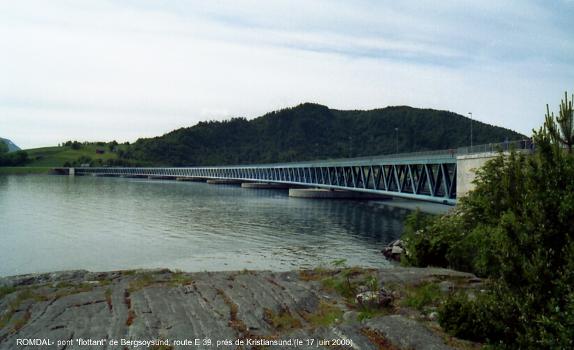General Information
| Name in local language: | Bergsøysundbrua |
|---|---|
| Completion: | 1992 |
| Status: | in use |
Project Type
| Structure: |
Pontoon bridge Deck truss bridge Warren type truss bridge Continuous truss bridge |
|---|---|
| Support conditions: |
for registered users |
| Function / usage: |
Road bridge |
| Material: |
Steel bridge |
| Plan view: |
Structurae Plus/Pro - Subscribe Now! |
Location
| Location: |
Kristiansund, Møre og Romsdal, Norway |
|---|---|
| Coordinates: | 62° 59' 11" N 7° 52' 25" E |
Technical Information
Dimensions
| main span | 106 m | |
| total length | 933 m | |
| number of spans | 13 |
Materials
| truss |
steel
|
|---|---|
| pontoons |
concrete
|
Notes
The bridge, which is the first of its type in the world, without stays or mooring lines, was opened in 1992. It has a design life of at least 100 years.
The bridge was towed into position from Verdal on Trondheims fjord. Bergsøysund is about 16 km ESE of Kristiansund, and 130 km WSW of Trondheim, at latitude 62°00' N and longitude 7°52.5' E.
Excerpt from Wikipedia
The Bergsøysund Bridge (Norwegian: Bergsøysundbrua) is a pontoon bridge that crosses the Bergsøysundet strait between the islands of Aspøya (in Tingvoll) and Bergsøya (in Gjemnes) in Møre og Romsdal county, Norway. The bridge is 931 metres (3,054 ft) long, the longest span is 106 metres (348 ft), and the maximum clearance to the sea is 6 metres (20 ft). The bridge has 13 spans.
Bergsøysund Bridge was opened in 1992. It is part of the Krifast system, the town of Kristiansund's road connection to the mainland. The bridge cost 277.4 million kr.
Construction
Floating bridge/pontoon bridge construction has a long history in military and civilian applications on every continent except Antarctica. According to the engineers who designed this bridge, it was designed using recent American technology for floating bridges, combined with Norwegian technology for offshore platforms. The bridge designers researched other bridges in the world and traveled to the state of Washington in the United States to visit the Homer M. Hadley Memorial Bridge and the Hood Canal Bridge—two floating bridges. The continuous floating concrete structure used in the Washington bridges was ultimately ruled out in favor of the discrete floating concrete pier design. This design afforded: 1) an elevated roadway that reduced traffic hazards in storms, 2) a reduction in corrosion of the bridge deck, and 3) improved passage of water beneath the bridge thereby supporting native species.
Text imported from Wikipedia article "Bergsøysund Bridge" and modified on 3 March 2023 according to the CC-BY-SA 3.0 license.
Participants
- DNV Veritec (superstructure)
- Johs Holt AS (substructure)
Relevant Web Sites
Relevant Publications
- (1993): The Bergsøysund Floating Bridge, Norway. In: Structural Engineering International, v. 3, n. 3 (August 1993), pp. 142-144.
- (2003): Floating Bridges: Past and Present. In: Structural Engineering International, v. 13, n. 2 (May 2003), pp. 128-132.
- About this
data sheet - Structure-ID
20005140 - Published on:
18/09/2002 - Last updated on:
16/02/2023





